Chances are if you grow green onions or bulb onions you’ve had to deal with thrips some time during the production cycle. Onion thrips (Thrips tabaci) can be a pest anywhere onions are grown.
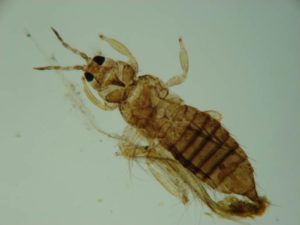
“They tend to be a bigger problem in hotter, drier climates,” said Tim Waters, professor and regional vegetable specialist at Washington State University Extension in Pasco, Wash. “In western states where there is a drier climate, thrips tend to be more of a problem than in wetter climates. In those climates with more precipitation, juveniles tend to get dislodged from the plants so there is some juvenile mortality from rain events.
“In arid climates where irrigation is used, there tends to be higher thrips populations where drip irrigation or furrow irrigation are used than in fields watered with overhead irrigation. In areas with warmer climates, there can still be high populations of thrips even if overhead irrigation is used. The warmer the temperatures the more quickly thrips go through their life cycle so more generations are produced and therefore more overall offspring.”
Onion thrips are not only a pest on onions and can infest other vegetable crops.
“Onion thrips infest brassica crops like cabbage and broccoli,” said Ken Samoil, research coordinator and study director at IR-4 Project in Princeton, NJ. “They infest asparagus, sugar beets, cucurbit crops, potatoes, strawberries, tobacco, cotton and some ornamental crops. Onion thrips can do major damage to some of these other crops as well.”
Differences in varietal susceptibility
Samoil said some onion varieties that have a more open growth center are less attractive to onion thrips.
“When the leaves are spread apart on the plant that is not preferable to the thrips,” he said. “The thrips like the leaves to be held tightly together. This allows them to hide and protects them from rain, irrigation water and wind.
“There are more differences in the growth habit of dry bulb varieties as far as whether the leaves are tight or not. Most green onion varieties are susceptible to onion thrips.”
Waters, who conducts variety evaluation trials, said there are certain onion varieties that are more susceptible to thrips feeding than others.
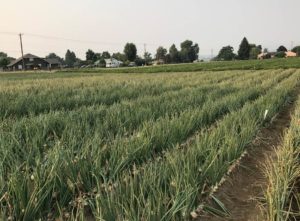
“Part of it is due to the waxes on the leaves and the color that the thrips perceive,” he said. “Onions that have dark blue-green leaves tend to have more thrips than lighter colored leaves with less wax on them.
“Thrips like to be in tight places because it is a good way to avoid predation. Anything that is out on the tip of the leaves is going to be exposed. If the thrips are hidden in tight spots they’re going to be more protected. It is also harder to deliver pesticides to onions with an erect and closed neck than to onions with a more open growing neck. Some of the insecticides applied for thrips control are systemic, but some are contact insecticides.”
Virus vector
In addition to causing damage to the crops they infest, onion thrips can also vector iris yellow sport virus (IYSV).
“Iris yellow spot virus can infect allium crops, including ornamental alliums,” Waters said. “One of the onion crops that may be more significantly harmed by the thrips and the virus are onion seed crops. These seed crops are in the ground for a longer period of time so there are more chances for them to be damaged by the thrips and the virus. When the virus affects the scape on which the seed grows, the scape can lodge causing the onion seed head to the ground making harvest difficult.”
Waters said the disease is more prevalent in certain parts of the country and depends on the crops being grown.
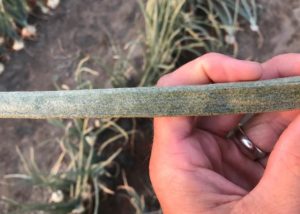
“In southern California there are good growing conditions all the time,” he said. “Onions are grown year round. If there are onions in the ground all the time, there is a reservoir for the virus. The virus has to persist on green tissue.This is referred to as the greenbridge.
“In areas that have a hard winter and there is no seed onions or green onions grown, then there isn’t going to be much iris yellow spot virus. In areas where seed onions and bulb onions are in near proximity there is going to be green onion tissue almost every month, so the virus is going to be present in that tissue and can be transmitted to nearby onion crops.”
Looking for additional controls
Waters said because onion thrips can go through an average of six to eight generations during the bulb onion production season, growers and researchers are always looking for effective chemical controls.
IR-4 received requests from entomologists in three different states for the registration of the insecticide tolfenpyrad for use on dry bulb onions.
“In 2007, I began working with tolfenpyrad on onions in collaboration with Dr. Doug Walsh, an entomologist at Washington State University,” Waters said. “Initially we did rate studies. Then we looked at the residual. The next thing we look at especially for thrips is how to utilize a pesticide throughout the season. We don’t want to use the product every time we need to control thrips. We want to figure out the best timing to utilize the pesticide.
“We also worked with tolfenpyrad on potatoes. We looked at application methodology and how growers might apply the insecticide, which includes aerial applications by airplane, by ground application, by a center pivot through chemigation systems and by injection through drip irrigation systems. Once chemicals are labeled growers want to know which application systems can be used to apply them.”
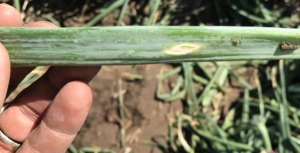
Samoil said chemical registrants sponsor some performance trials, but not for all the specialty crops that IR-4 handles.
“The registrants focus on a few crops that they think a pesticide is particularly well suited for,” he said. “Everything else is up to IR-4 to gather, both the performance and the residual data.”
Sixteen performance trials were conducted with tolfenpyrad on onions in eight states between 2005 and 2014. Residual studies included six dry bulb onion trials in six states and four green onion trials in four states.
“As it relates to tolfenpyrad’s use, there really isn’t any difference if the onions are grown for green onions or dry bulb onions,” Samoil said. “The application rates and time of applications were the same. There was nothing different as far as how green onions and how dry bulb onions were treated.”
Preventing resistance
In most parts of the country where dry bulb onions are produced only one crop is planted in a season.
“Dry bulb onions are a long season crop,” Waters said. “Typically plants are started in the spring and harvested in the fall. “The tough thing with onion thrips is the long control season. With some pests, growers only need to make one to two applications to gain control for the season.
“We strongly recommend that growers make no more than two applications of any compound throughout the onion growing season and that these chemicals be applied in sequence. Growers should rotate tolfenpyrad with other insecticides. The reason growers shouldn’t rotate applications between chemicals is because there are so many generations during the growing season.
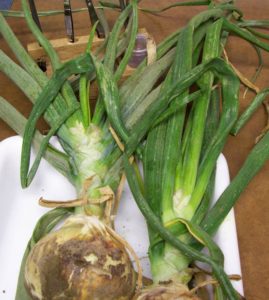
“There are a number of compounds that are relatively effective against onion thrips. With onion thrips growers may make up to 10 applications to control the pest. The average number of applications is six to eight.”
Even though there are more chemicals available to control onion thrips, Waters said growers need to be concerned with resistance development.
“We are starting to see some resistance develop to Lannate,” Waters said. “Synthetic pyrethroids used to be really effective for thrips control. Now when I do studies that include synthetic pyrethroids, by the third week in the trial there are more thrips in the plots treated with the pyrethroids than the untreated checks. Those products were widespread, inexpensive and overused and they are no longer as effective as they once were.”
Waters said control of thrips early on in the season is really important. If the thrips aren’t managed, their population can grow almost exponentially.
“We help growers come up with a control plan through the season,” he said. “We recommend that growers go out once a week and scout their crops. A lot of growers scout their crops over the season and keep records. We recommend that growers adjust their control plans based on what they are seeing in their fields. If they start seeing thrips early in the season, they have to adjust their plans and start treating the plants. If they aren’t seeing the thrips until later in the season, they can delay treatments. They should modify their control plans as they need to.”
For more: Tim Waters, Washington State University Extension, Pasco, WA 99301; twaters@wsu.edu.
PR#09657 Onion Bulb and Green Subgroups (Onion thrips)
David Kuack is a freelance technical writer in Fort Worth, Texas; dkuack@gmail.com.
